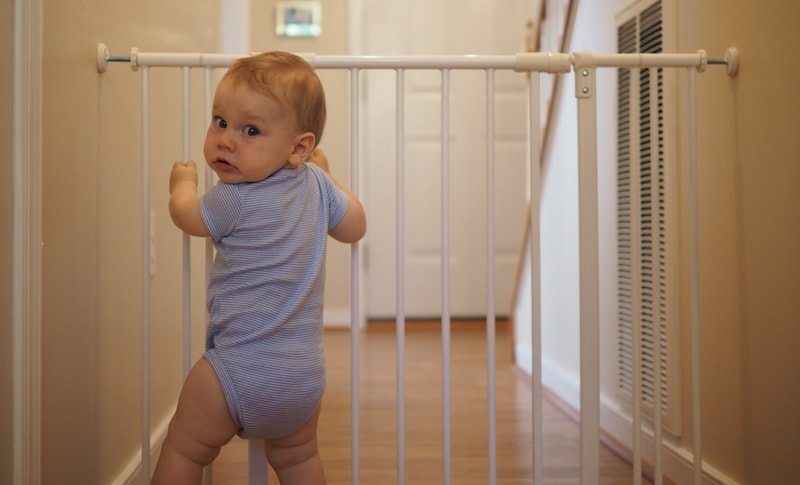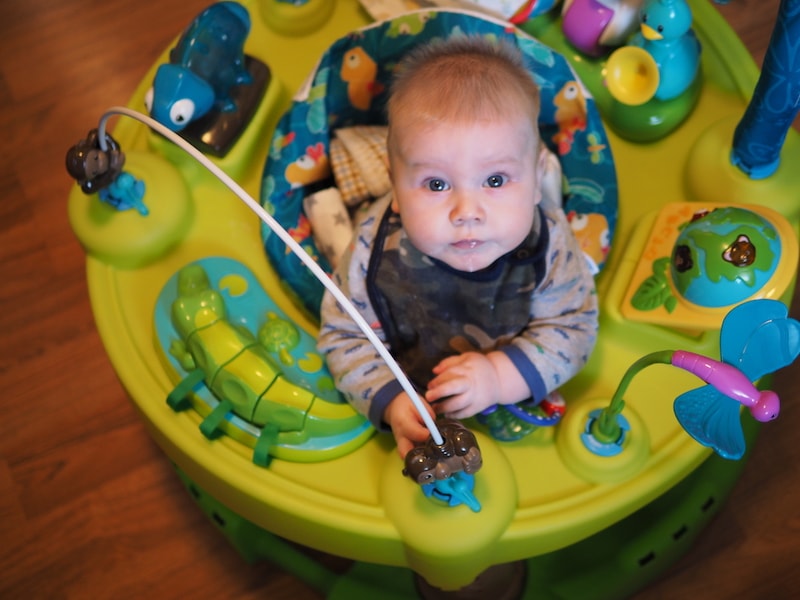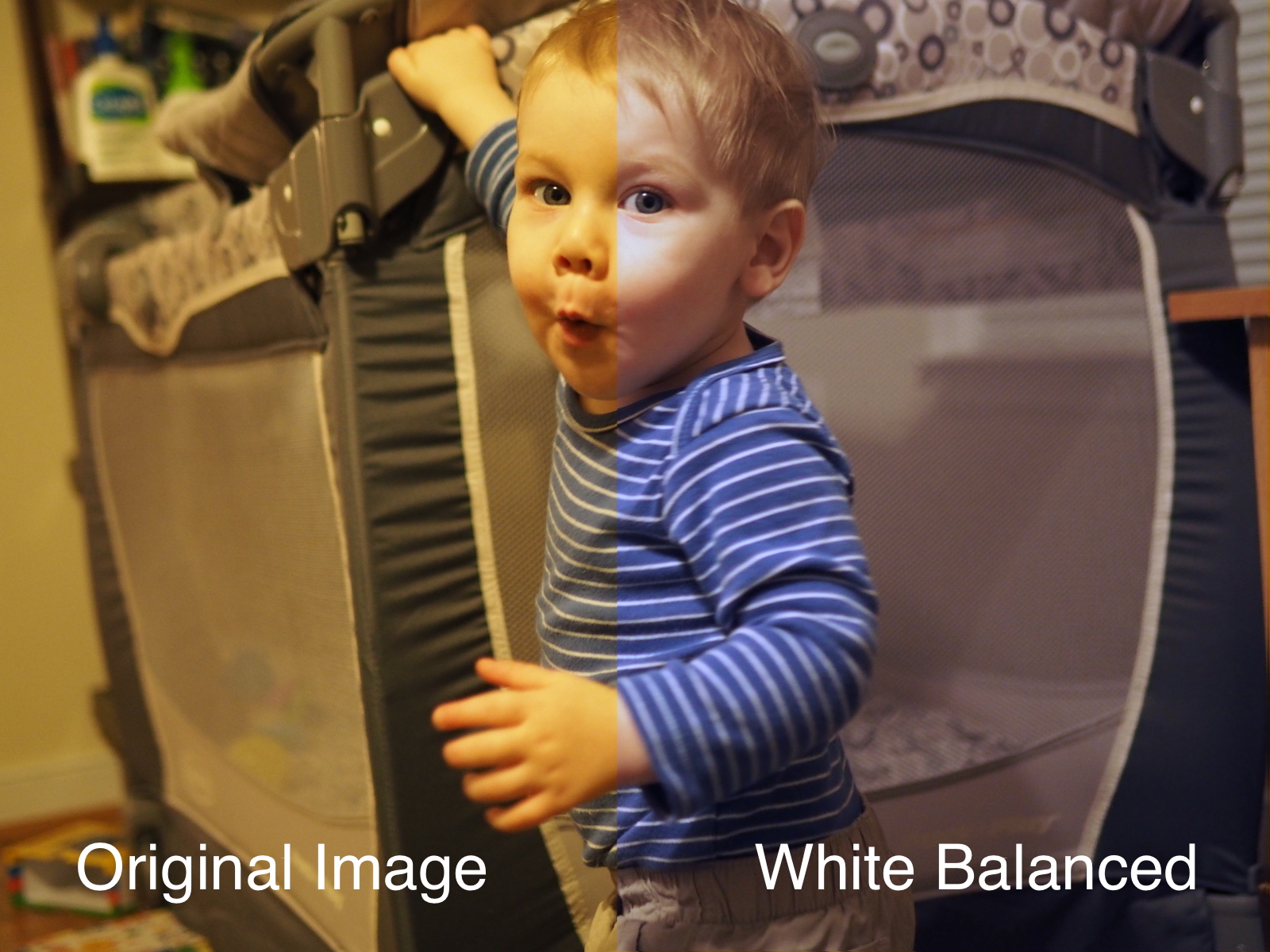
Over a year ago, Erin and I collaborated to come up with a list of baby stuff we use. Now that Declan is a bit over a year and a half old, we thought it was about time for a new version. Here we cover toddler-related things.
The disclosure from last time applies again here:
This is not a Wirecutter-style “this is the best available” sort of post. Unless otherwise noted, while we did extensive cross-shopping, we didn’t buy alternatives. If you’re looking for that kind of a post, try Marco/Tiff’s or The Night Light.
So, the Declan-approved stuff:
Travel Crib — Lotus Travel Crib — $210
Since the baby stuff post, we’ve been on two plane journies with Declan. During
those trips, we didn’t want to bring the full-size Pack 'n Play. A coworker
recommended the Guava Family Lotus Travel Crib. The key to this crib is that it
folds up to be carry-on size on the plane. It also has a side zipper so it can
be used as a play area.
Baby Gate — North States Supergate — $50
Once Declan was crawling, we didn’t want to have to hover over him. We bought
two of these baby gates; one is at the top of the stairs, and one is in the
downstairs hall leading to the stairs. The gate is easy to install, and easy
to open or close one handed. Further, there (shouldn’t) be any permanent damage
to the walls, as they work by tension rather than screws or equivalent. I’ve
wrenched on ours really hard, and it hasn’t moved a millimeter.

Cabinet Locks — Magnetic Safety Cabinet Locks — $20
Being mobile now, Declan loves to get into all our below-the-counter cabinets.
Naturally, we wanted to lock them, but wanted to do so in such a way that they
don’t look any different from the outside. Erin found these ingenius cabinet
locks that work via magnets. You put the “key” up against the cabinet, where
the lock is on the inside, and it forces the lock to unlock. It makes me smile
every time, and the locks have withstood Declan pulling on them with all his
might.
Pillow — Little Sleepy Head Pillow — $20
Erin noticed months ago that any time Declan was around a pillow; say a throw
pillow on the couch downstairs, he loved putting his head on it. She found the
Little Sleepy Head Pillow online, and Declan loves it. Roughly half the size of
a throw pillow, it’s the perfect size for his little head. When it was new, it
was just a touch thicker than we would have liked, but Declan has always loved it.
Sleep Sack — HALO SleepSack — $20
When Declan was a baby, he loved being swaddled. Eventually, he grew out of the
swaddlers. To this day, we’re clinging to the SleepSack. Declan is a very mobile
sleeper, and these seem to work well for him. However, he’s currently in an
extra large, which means our time is running out. Keep us in your thoughts.
Milk Cup — Munchkin Miracle 360 Trainer Cup — $12
Once Declan seemed capable of holding a cup, we tried to encourage him to do so.
Since that time, we’ve consistently used the Munchkin Miracle cup. It’s generally
spill-proof, and he has never had any issue drinking from it. The only catch is,
you really need to ensure the colored rubber lid is on properly; if it doesn’t
seal, the contents will spill everywhere. I’ve found if I push down on the center
a few times, that does the trick.
Water Cup — Munchkin Click Lock Flip Straw Cup — $6
For water, we really like the Munchkin Click Lock straw cups. When assembled
properly, they don’t leak unless you really mess with them. That said, it is
annoyingly easy for me to assemble them just slightly wrong. Nonetheless,
these cups work really well and Declan has been using them for months.
Snack Cup — OXO Tot Flippy Snack Cup with Travel Lid — $6
We also tried the Munchkin Snack Catcher, but it didn’t take long for
Declan to figure out how to take the lids off of those. Once the lid was off,
the contents got everywhere. Our experience has been far better with the Oxo Tot
cups. Declan can’t get the lid off, and doesn’t have problems getting the contents
of the cup out.
Disposable Bib — Bibsters Disposable Bibs — $11
When we go out to eat, which we’ve done probably once a week since Declan was
able to sit in a high chair, we’ve always used these bibs. Much easier than
taking a bib from home that must return there; these are disposable. They
are made of thick paper with a waterproof lining in the back, have a crumb
catcher, and do the trick when we’re out.
Disposable Placemat — Neat Solutions Table Topper — $16
We haven’t gotten these exact ones, but we’ve used other Neat Solutions disposable
placemats. Each of the four sides has tape on it, and you stick the placemat to
the table at the restaurant. The strips that cover the tape are ostensibly made
of static-cling plastic, but I’m convinced they’re really rare earth magnets.
Despite the super clingy strips, these placemats work well, and make cleanup easy.
High Chair — Graco Blossom 4-in-1 Seating System — $175
Far spendier than we’d prefer, we went with the Graco Blossom because it will
grow with Declan. We’re using it in toddler configuration; it’s as pictured on
Amazon, but without the insert for infants. The Blossom is sturdy, wheels around
easily when we want it to, and is height-adjustable. Once Declan outgrows it as
a high chair (which I suspect will be happening soon), we’ll convert it to a
booster.

Stroller — Graco Aire3 — $180
We’re still using the stroller from the travel system we bought when Declan was
a newborn. However, the link above is for the stroller as a standalone item. We
still like the stroller and use it nearly daily. For more, see the baby stuff
post.
Walker — VTech Sit-to-Stand Learning Walker — $30
The VTech walker is probably most responsible for teaching Declan how to walk.
He loved pulling up on this, and eventually pushing it around. Intrestingly,
the little toy telephone handset on here may be the only exposure to a
traditional telephone that Declan will ever have.
Exersaucer — Evenflo Life in the Amazon Exersaucer — $90
In addition to the walker, we wanted to get Declan something that he could
use while stationary. The Exersaucer was that toy for him. Declan loved
being in this thing. It allowed him to bounce, spin, and play with various toys.
He particularly liked the globe, which has buttons on it that make noises. Once
he eventually outgrew it, the Exersaucer can be deconstructed to form a sort of
S shape that he can then walk up to and play with. He still plays with it
occasionally to this day.

Solid Food Freeze Tray — Mumi&Bubi Solids Starter Kit — $26
Erin, because she didn’t have enough on her plate, decided to make Declan’s baby
food herself. We did buy some from time to time, but the overwhelming majority
Erin made by hand. In broad strokes, she would cook a fruit or vegetable, and
then use a standard immersion blender to mash it. (Any baby-specific blenders
seemed like a total waste of money and tend to carry huge markups.) Once the
food was blended, she would put it in these food trays to freeze them in one
ounce chunks. These now-frozen chunks can then be moved into ziplock bags and
stored.
Car Seat — Graco 4ever All-in-One Car Seat — $300
Declan eventually outgrew his infant seat (but as mentioned above, not the
associated stroller), and we needed to get him a new car seat. We opted for
the Graco 4ever seat, which in theory is the only car seat we ever really
needed to buy. It’s designed to work from infants all the way through
children in booster seats. We bought one for each car, and we haven’t had
any problems with it.
As part of their coverage of WWDC, John Vorhees of MacStories took the time to interview some developers and get their reactions to the events of the week. I was among those interviewed, along with a ton of my friends, and a couple of others.
Across a total of sixteen interviews, ranging from 7 minutes to my 31, you can hear a variety of different reactions, opinions, and discussions. My agenda tomorrow is to go through each and every one of them to see what I didn’t see, didn’t hear, or didn’t think about during WWDC.
Layers is the fantasy conference we all wish existed, but are too scared or preoccupied or wimpy to put together. Jessie and Elaine were neither scared nor wimpy, and didn’t care that they were preoccupied. I am so very happy I was able to attend Layers.
Layers is a design conference at its heart, but it’s really so much more than that. Taking many spiritual cues from the dearly departed Çingleton Symposium, Layers brings together designers and developers, forces them to mingle, and then gets out of the way. Perhaps the best summary is on their website:
Layers is a 3-day conference during WWDC to talk about design, celebrate our industry, and eat snacks.
Like a party, but for learning.
Elaine and Jessie do an incredible job putting Layers together, catering to us for two days and change. To illustrate, there was a hangover table with all the tools (read: aspirin) required to get over a hangover. The mid-morning and mid-afternoon snacks were considered sessions in their own right. The coffee bar—I’m talking the kind with baristas—also made hot chocolate. These women get me.
Perhaps most importantly, this conference made me think differently about how I perceive those around me. We’ve been talking as a community, and me on my podcasts, about the tech industry being more inclusive. Layers proved to me the power of that inclusivity.
The overwhelming majority of the presenters at Layers did not look like me. They were either not male, not white, not cisgendered, or not straight. Sometimes a combination of all four.
By the third presentation—perhaps the most powerful of the show—it was clear to me how wonderful it is to hear voices that are not like my own. Most of the time, the fact that these voices were so different was irrelevant; the content stood on its own. (You could even say it was like a… ahem… meritocracy.)
From time to time, it was striking that I was not listening to voices like mine. I was not looking at faces like mine. And I was better for it.
It also doesn’t hurt that unlike some other conferences, Layers has a clear Code of Conduct. Sometimes the little things aren’t so little. Plus, the Code of Conduct is chock-full of emoji. How can you not like that?
During the two days at Layers I ate great food, got great swag, met great people, participated in group power stances, learned great things, danced, tied rope, and made lasting memories.
If you find yourself with a couple of days in San Francisco in June, do yourself a favor: go to Layers. You won’t regret it.
It’s always fun to do a guest spot on a podcast. I can now say that it’s even more fun to do so when my wife Erin is with me.
This week, Erin and I joined Tiff and Marco Arment on their show Top Four. On this episode, we discussed something near and dear to my heart: Top Gear.
Any excuse to watch Top Gear works for me, so preparing for this episode was just terrible. Nevertheless, picking my Top Four was difficult, and I can honestly say I was stunned by Erin’s choices.
It was a ton of fun to record this episode with our dear friends. Furthermore, it’s always fun to talk about things that you truly love; Erin and I both really love Top Gear. I think you’ll really enjoy this Top Four, even if you’re not a Top Gear fan.
Possibly my favorite feature of my iPhone is Apple’s new Live Photos. Live Photos takes a couple seconds of video before and/or after a still photograph is taken. When you deep press (or on some phones, tap-and-hold) on a photo, it will animate and show a couple seconds of video.
Just a couple seconds of video provides an unbelievable amount of context, and really makes photos come alive. It’s much like the newspapers in the Harry Potter series. I love Live Photos.
In much the same way my friend David Smith released LiveToGIF (iTunes Link) to create GIFs out of Live Photos, Becky Hansmeyer’s new Live Rotate (iTunes Link) utility allows you to rotate Live Photos. With the out of the box Photos app on iOS, you can’t edit a Live Photo—say, to rotate it—without removing the live part.
Becky’s app Live Rotate fixes this. You can quickly and easily rotate Live Photos, and save them as copies in your camera roll.
In much the same way as David’s apps, Live Rotate does one thing and does it well. I immediately bought it; it’s $0.99 on the App Store.
A few quick notes about travel for WWDC:
- I just updated my chart of T-Mobile and Verizon data plans for those like myself that like to rock iPads with LTE. (See also my post about the Apple SIM)
- For foreign travelers with unlocked phones, you may be interested in
T-Mobile’s new Tourist Plan. It offers:
- Unlimited data (the first 2GB at LTE speeds; after that I believe it’s 2G)
- Tethering is enabled and comes out of the same data allotment
- Unlimited domestic and international text messages to many countries
- 1000 minutes of domestic talk time
- For domestic travelers, if your airline uses Gogo, I strongly recommend buying a day pass for $16 before you go to the airport. Though $16 is fairly steep for a few hours of WiFi, it’s considerably more if you buy on the plane. Plus, you have a year to actually use it.
- Weather in San Francisco at this time of year is really peculiar. It tends to be just a touch too warm during the day and a touch too cool at night. Where do you think the [Bring Your] Layers conference got its name?
- Even if you’re like me and rock an Anker PowerPort in your go pack, I find it’s really nice to keep an iPad USB Brick accessible while traveling. It comes in handy at charging stations in the airport, as well as while you’re on the plane, if your carrier has AC power at every seat.
- Traveling from San Francisco International Airport to the
Moscone area via BART is pretty straightforward:
- When you land in SFO, take the AirTrain to the International Terminal
- Go up to the departures level and follow the signs to the BART station
- Order a ticket with the appropriate fare on it; it’s around $20 to go round trip.
- Board a Pittsburg/Bay Point train
- Around 30 minutes later, get off at Powell Street
I’ll be at Layers this week; I hope to see you there, or around San Francisco! If you do happen to spot me, please say “hi”!
I discovered downtempo music thanks to a friend introducing me to Rob Dougan in college. Several years later, a coworker mentioned a band he really liked: Zero 7 (Spotify).
The name meant nothing to me, until I heard their song In the Waiting Line (Apple Music, Spotify, iTunes). I knew it from the movie Garden State, a film which played a very important role in my life. That’s a story for another day.
As with any new thing I enjoy, I binged on Zero 7. Their body of work, while impossibly good, is not vast. Nevertheless, I still have their albums on rotation constantly.
Zero 7, to my ear, is rooted in jazz, but with the instrumentation of modern electronic music and some of the rhythmic feel of funk. Zero 7 at its core is a pair of producers and songwriters; the vocalists they choose to work with are incredible.
One such vocalist is José González. In much the same way I was dumbfounded by the In the Waiting Line connection, I was also gobsmacked by the realization that Zero 7 frequently works with José González as one of their vocalists. Over the last few years, I’ve found myself falling more and more in love with José’s solo work. It wasn’t until I played a Zero 7 track immediately after one of his I made the obvious connection. Unsurprisingly, I love José’s collaborations with Zero 7.
Recently I stumbled on Zero 7’s performance at the Glastonbury Festival in 2004. The entire concert is available on YouTube.
The quality of the recording is not great. It looks to my eye to be sourced from VHS, and some moron in the audience thought blaring a whistle was an appropriate substitute for clapping. Despite that, the quality of Zero 7’s performance is astounding.
I tend to have music on in the house when we’re all just hanging out. I also generally drive short distances, so I rarely listen to podcasts while driving. At home and in the car, Zero 7’s Glastonbury 2004 show has been played constantly.
A few highlights to get you going:
- Warm Sound kicks everything off aggressively. It ends with vocalist Mozez barely able to contain himself as he belts out the repeated end line.
- Look Up quickly dives into a great guitar solo, and is finished up by incredible vocals from Tina Dico.
- Somersault brings modern-day powerhouse Sia on stage. Being this was filmed in 2004, this was before Sia began hiding her face.
- The Space Between takes a lovely meandering path to a keyboard solo at the end which kills me every time. My favorite selection of the show.
I wish so badly I was in the audience for this set. It must have been absolutely breathtaking. I’d also love to have a better recording of the show, but in my searches this is the only source—audio or video—on the internet. Nevertheless, I’m very thankful I have this much.
The whole set is less than 90 minutes. Paired with a beverage of your choice, it’s a great way to spend an evening.
And you see people scream at their kids, and beat them in Kroger, and you just want to die because you would give anything to have a child throwing a tantrum in the cereal aisle.
Everyone’s journey through infertility is a little different. I’ve discussed ours in the past. Facebook user Dan Majesky eloquently documents his.
So much of this hit home.
I’ve been asked a few times how I manage my photos. I’m no expert in the matter, but I have a system that works for me. This is that system.
Ground Rules
To start, let’s look at my motivations:
- All my photos available on any internet-connected computer/mobile device
- Backups to at least two cloud services
- Robust location metadata
- Getting at source files quickly and easily once I know a date
The things that I’m not concerned with:
- First-party Apple apps don’t matter (including the photo picker on iOS)
- File names that describe their contents don’t matter
- Collecting in albums doesn’t matter
- Tagging faces doesn’t matter
- Pulling photos wirelessly doesn’t matter
Short-short Version
(Image Capture or direct SD card connection) →
GeoTag if necessary →
Dr. Drang’s script →
Synology →
(Google Photos and CrashPlan)
Importing Files
All of my photos begin in one of three places:
- My iPhone
- Erin’s iPhone
- Our Camera
For both iPhones, I will periodically connect them to my iMac and import all of their photos using OS X’s built in Image Capture.
For the camera, I will pull the SD card and put it in my iMac. My script will automatically copy them off of the card.
Culling
I shoot on our big camera in JPEG + RAW. The first step to a photo import is to use Finder to go through each of those files and delete those that I don’t want. For me, that means deleting most RAW files, and deleting both JPEG/RAW for photos I don’t care for. Sometimes that means they’re blurry, sometimes that means they’re poorly composed, sometimes someone is blinking, etc. I tend to err on the side of keeping JPEGs and tossing RAW files.
Anything I think I’ll possibly want to blow up, print, or otherwise manipulate I’ll keep in RAW. Additionally, I’m far more likely to keep RAW files for photos taken during special events such as birthdays or holidays.
Editing
Generally speaking, I do not edit my photos. I know that I have a lot to gain by making edits, but I don’t have the time nor patience. The only exception is correcting white balance for photos taken indoors. I use Preview to do so:
- Open a photo
Tools→Adjust Color...(or ⌥⌘C)- In the tool window, click the eye dropper that’s adjacent to the
Tintslider - Find something in the photo that is flat white, and click on it
Correcting the white balance takes me about 30 seconds per photo. In the case of, say, a birthday celebrating indoors at night, that adds up fast. However, correcting white balance can make a profound difference in photos taken indoors with artificial light:

Geotagging
For images taken on our camera, most of them tend to be without geotags. I quite frequently search for my photos by the place they were taken, so accurate geotags are important to me.
Generally speaking, especially if I’m going to be in one place (such as a business or house), I don’t bother having the camera geotagging at the time the photos are taken.
If I’m somewhere that involves a lot of moving around; such as an park or walking around a city, then I’ll take the time to have my phone track my location using the Olympus OIShare app. Once I’m done taking pictures, I can have the phone amend the pictures I’ve taken with geotags it’s accumulated as it was tracking.
For those times I didn’t bother going through the effort of “live” geotagging, I use the free and appropriately named app GeoTag. GeoTag is not particularly fancy, but it allows me to quickly and easily add geotags as I’m importing the images off the SD card.
Sorting
Once I’ve performed any culling and editing, it’s time to move the photos to
their permanent home. For me, that’s my Synology. I have two modified
versions of the same script that I stole remixed from Dr. Drang.
My version is here; this particular one is the one I use for photos that Image Capture has pulled off my iPhone (you can tell here). I have a second copy of this script that is identical except for line 22, which points directly to where my SD card mounts.
Yes, I’m aware I can combine these scripts, but I actually like that I have
to force myself to type organize-photos or organize-iphone-photos to
protect me from myself. This is what works for me; your mileage may vary.
This script will rename every photo, regardless of source, in the format
2016-05-29 15-03-45.jpg
In this case, a photo was taken 29 May, 2016 at 3:03 PM.
The script will discover the date and time the photo was taken based on the EXIF data stored within the image. (Dr. Drang explains more on his blog.) Furthermore, it will automatically create a folder structure so that all photos are grouped by the year and month they were taken.
The one catch is that I haven’t yet modified it to account for RAW files; it
will inspect them and rename them, but it won’t keep the original ORF
extension. Thus, after I import, I go to the directory the photos were dumped
into, and run this quick command:
find . -size +10000k -exec rename -s .jpg .ORF '{}' ';'
That command will look at everything that is larger than 10 MB and rename it
*.JPG → *.ORF. One of these days I’ll modify the script to account for
this, but that day isn’t today.
Rejoice
Once the files are on the Synology, they’re automatically uploaded to both Google Photos and CrashPlan. Generally speaking, if I need to find a photo, I turn to Google Photos to figure out when it was taken, and then turn to the local file on the Synology to get to the source.
Since all the photos are organized by year and month, and then named by the date they were taken, going from the date I found using Google Photos to the source file takes but moments.
For special events, like vacations or birthdays, I’ll create a Google Photos album of those photos for quick access. For day-to-day photos, I find them by using Google Photos’ stunning search system.
This is my workflow. There are many like it, but this one is mine.
There are few restaurants I would travel two hours for. When I met Erin, a couple months after we started dating, I told her what I wanted for my birthday. I wanted to drive from Charlottesville to Catawba—125 miles—for dinner.
Erin is the best, so that’s what we did. We went to The Homeplace.
The first time I went to The Homeplace was when I was at school at Virginia Tech. Like a legend, students would pass down tales of how delicious The Homeplace was. It didn’t take long before I had to try it for myself.
Though I haven’t been in years, at the time, the menu was simple. You could choose two meats for around ten dollars, or have all three for a dollar more. Your choices were:
- Fried chicken
- Country ham (salty, not sweet)
- Roast beef
Everything was served family style, and there were a ton of sides. Mashed potatoes and biscuits with apple butter were a given. Other options rotated, like green beans, baked beans, collard greens, and if you hit the jackpot, macaroni and cheese.
You would eat until you were uncomfortable, take a break, and eat some more. Inevitably, you’d well up in tears of both pain and joy as you realized you still had the dessert cobbler to get through.
A little while ago, a local news station ran a story on the background of The Homeplace. I loved learning about the history of one of my favorite restaurants, but I also enjoyed the story of the owner. Particularly of him meeting his then-engaged now-wife:
She showed me her diamond. I asked her:
Do you know where you got it?
Well, of course, why?
Well if you know where it came from, then send it back!
There is both an article and this video report (give it a moment to load):
Should you ever find yourself outside Roanoke, Virginia; do yourself a favor, and go to The Homeplace. Expect a line though: I’ve never had to wait less than an hour for a table. For good reason.